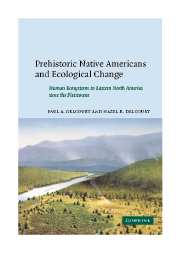 Prehistoric Native Americans and Ecological Change
Prehistoric Native Americans and Ecological Change Book contents
- Frontmatter
- Contents
- Acknowledgements
- PART I PANARCHY AS AN INTEGRATIVE PARADIGM
- PART II ECOLOGICAL FEEDBACKS AND PROCESSES
- 4 Gene-level interactions
- 5 Population-level interactions
- 6 Community-level interactions
- 7 Landscape-level interactions
- 8 Regional-level interactions
- PART III APPLICATION AND SYNTHESIS
- References
- Index
6 - Community-level interactions
Published online by Cambridge University Press: 30 October 2009
- Frontmatter
- Contents
- Acknowledgements
- PART I PANARCHY AS AN INTEGRATIVE PARADIGM
- PART II ECOLOGICAL FEEDBACKS AND PROCESSES
- 4 Gene-level interactions
- 5 Population-level interactions
- 6 Community-level interactions
- 7 Landscape-level interactions
- 8 Regional-level interactions
- PART III APPLICATION AND SYNTHESIS
- References
- Index
Summary
PREHISTORIC NATIVE AMERICANS AS AN INTERMEDIATE DISTURBANCE
By the late Holocene, after 4500 BP, Native Americans had demonstrable effects upon their ecological setting. Domestication of plants in riparian habitats resulted in cumulative effects on ecological relationships at the community level (Figure 3.4) as bottomland forests were cut and old-field communities developed. Late Archaic and Woodland people affected the proportions of native species in the vegetation surrounding their habitations by collecting fuelwood, selective use of fire, and gardening activities such as tillage, weeding, and establishing seed beds. These activities of prehistoric Native Americans constituted a form of intermediate disturbance that influenced biological diversity, both by altering species richness in the immediate surroundings of villages and rockshelters and by affecting the composition and distribution of plant communities along more extended ecological gradients from river bottoms to ridgetops.
THE RELATIONSHIP OF INTERMEDIATE DISTURBANCE TO BIOLOGICAL DIVERSITY
Several kinds of biological diversity can be measured directly. Alpha diversity, or within-habitat diversity, is determined by local species richness, measured by the total number of species found in a sample. Beta diversity, or between-habitat diversity, the rate of species turnover from one community to another along an ecological gradient, is measured by comparing the change in alpha diversity from one sample to the next. Gamma diversity, or landscape-level diversity, is the total number of species within a study area, where alpha diversity may change from one portion of an environmental gradient to another.
- Type
- Chapter
- Information
- Prehistoric Native Americans and Ecological ChangeHuman Ecosystems in Eastern North America since the Pleistocene, pp. 74 - 89Publisher: Cambridge University PressPrint publication year: 2004


